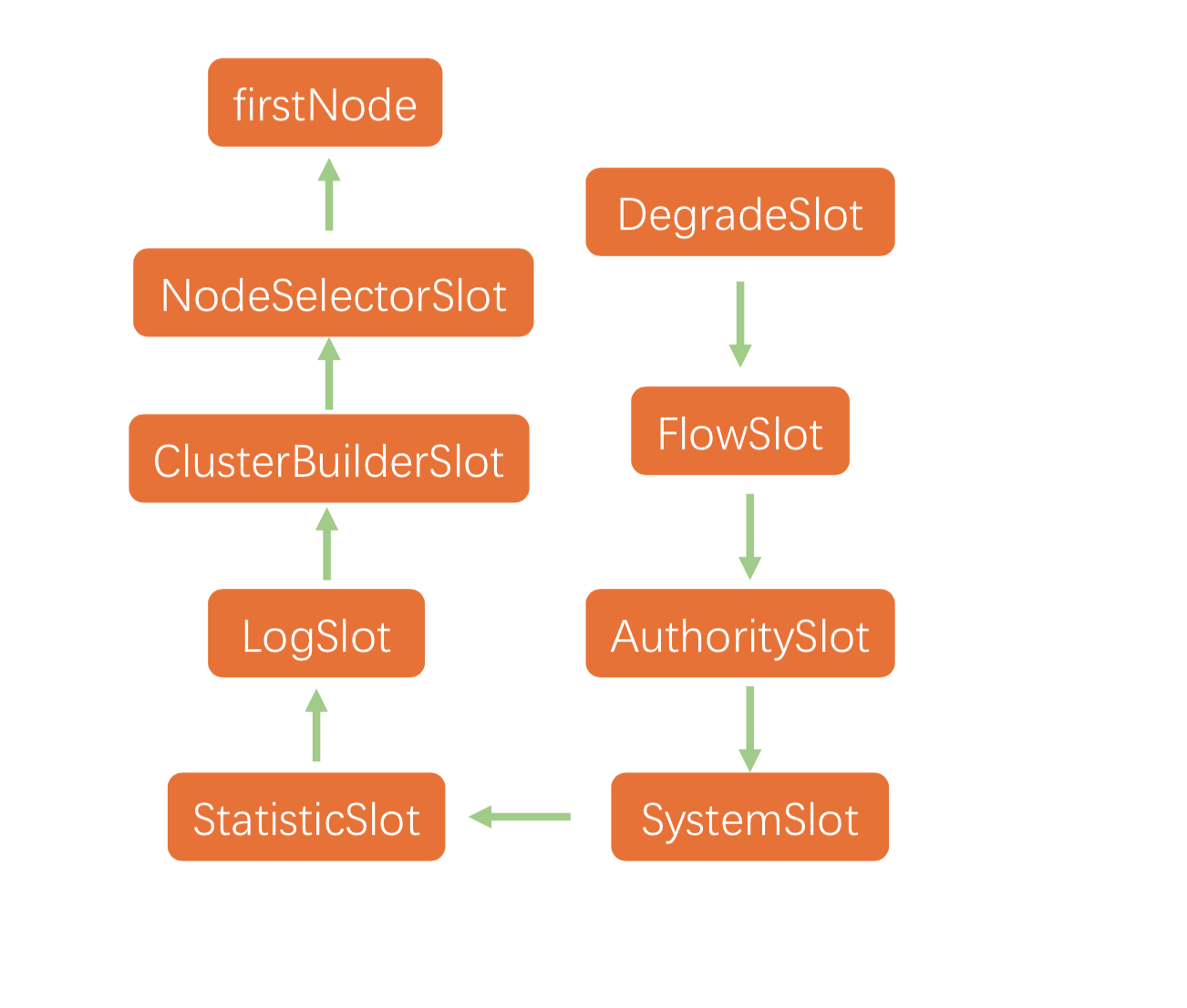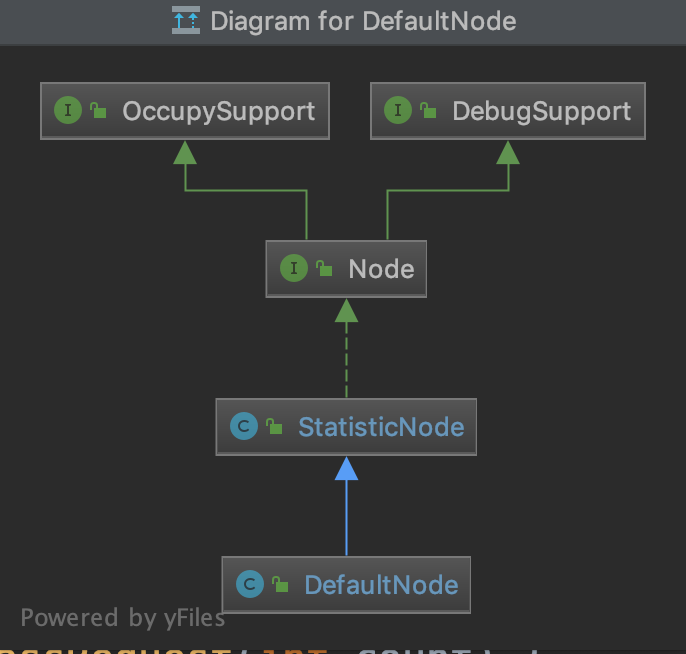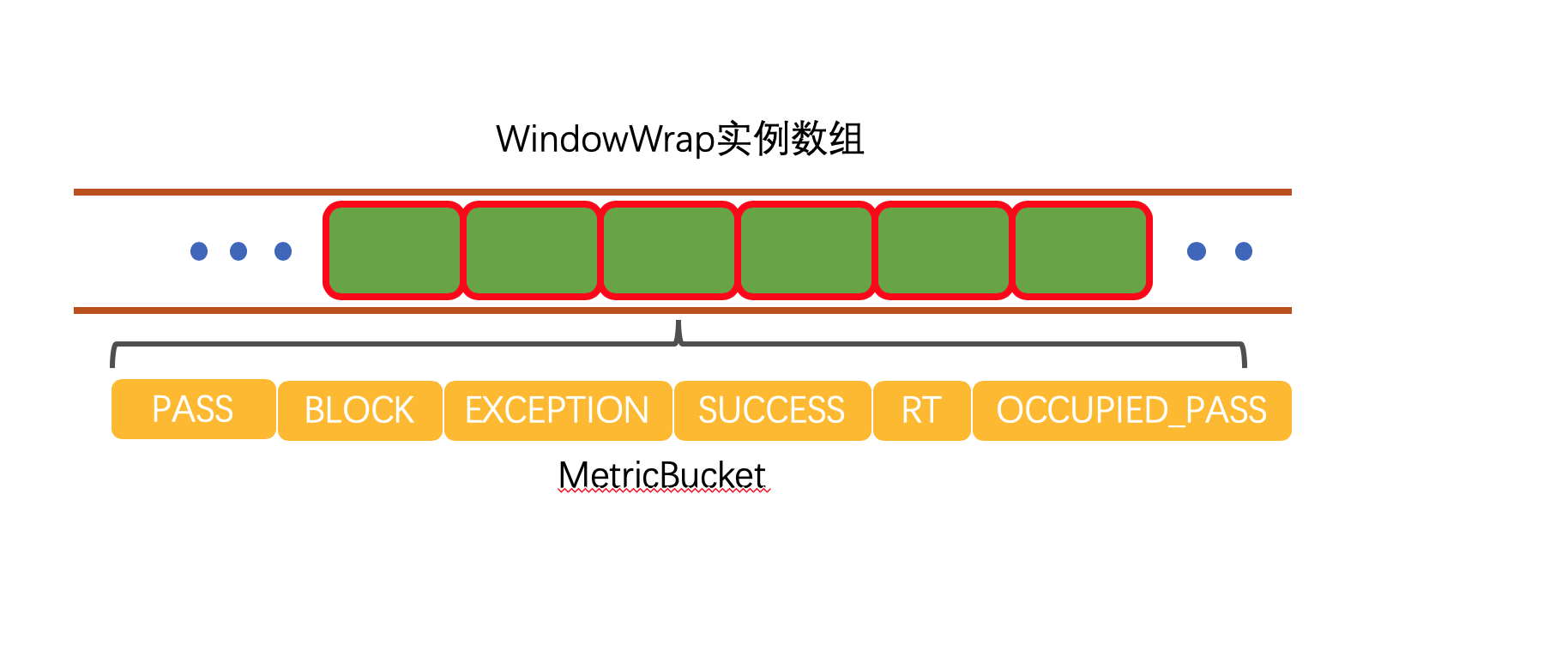2. Sentinel源码分析—Sentinel是如何进行流量统计的?
- 2019 年 10 月 3 日
- 筆記
这一篇我还是继续上一篇没有讲完的内容,先上一个例子:
private static final int threadCount = 100; public static void main(String[] args) { initFlowRule(); for (int i = 0; i < threadCount; i++) { Thread entryThread = new Thread(new Runnable() { @Override public void run() { while (true) { Entry methodA = null; try { TimeUnit.MILLISECONDS.sleep(5); methodA = SphU.entry("methodA"); } catch (BlockException e1) { // Block exception } catch (Exception e2) { // biz exception } finally { if (methodA != null) { methodA.exit(); } } } } }); entryThread.setName("working thread"); entryThread.start(); } } private static void initFlowRule() { List<FlowRule> rules = new ArrayList<FlowRule>(); FlowRule rule1 = new FlowRule(); rule1.setResource("methodA"); // set limit concurrent thread for 'methodA' to 20 rule1.setCount(20); rule1.setGrade(RuleConstant.FLOW_GRADE_THREAD); rule1.setLimitApp("default"); rules.add(rule1); FlowRuleManager.loadRules(rules); } SphU#entry
我先把例子放上来
Entry methodA = null; try { methodA = SphU.entry("methodA"); // dosomething } catch (BlockException e1) { block.incrementAndGet(); } catch (Exception e2) { // biz exception } finally { total.incrementAndGet(); if (methodA != null) { methodA.exit(); } }我们先进入到entry方法里面:
SphU#entry
public static Entry entry(String name) throws BlockException { return Env.sph.entry(name, EntryType.OUT, 1, OBJECTS0); }这个方法里面会调用Env的sph静态方法,我们进入到Env里面看看
public class Env { public static final Sph sph = new CtSph(); static { // If init fails, the process will exit. InitExecutor.doInit(); } }这个方法初始化的时候会调用InitExecutor.doInit()
InitExecutor#doInit
public static void doInit() { //InitExecutor只会初始化一次,并且初始化失败会退出 if (!initialized.compareAndSet(false, true)) { return; } try { //通过spi加载InitFunc子类,默认是MetricCallbackInit ServiceLoader<InitFunc> loader = ServiceLoader.load(InitFunc.class); List<OrderWrapper> initList = new ArrayList<OrderWrapper>(); for (InitFunc initFunc : loader) { RecordLog.info("[InitExecutor] Found init func: " + initFunc.getClass().getCanonicalName()); //由于这里只有一个loader里面只有一个子类,那么直接就返回initList里面包含一个元素的集合 insertSorted(initList, initFunc); } for (OrderWrapper w : initList) { //这里调用MetricCallbackInit的init方法 w.func.init(); RecordLog.info(String.format("[InitExecutor] Executing %s with order %d", w.func.getClass().getCanonicalName(), w.order)); } } catch (Exception ex) { RecordLog.warn("[InitExecutor] WARN: Initialization failed", ex); ex.printStackTrace(); } catch (Error error) { RecordLog.warn("[InitExecutor] ERROR: Initialization failed with fatal error", error); error.printStackTrace(); } }这个方法主要是通过spi加载InitFunc 的子类,默认是MetricCallbackInit。
然后会将MetricCallbackInit封装成OrderWrapper实例,然后遍历,调用
MetricCallbackInit的init方法:
MetricCallbackInit#init
public void init() throws Exception { //添加回调函数 //key是com.alibaba.csp.sentinel.metric.extension.callback.MetricEntryCallback StatisticSlotCallbackRegistry.addEntryCallback(MetricEntryCallback.class.getCanonicalName(), new MetricEntryCallback()); //key是com.alibaba.csp.sentinel.metric.extension.callback.MetricExitCallback StatisticSlotCallbackRegistry.addExitCallback(MetricExitCallback.class.getCanonicalName(), new MetricExitCallback()); } 这个init方法就是注册了两个回调实例MetricEntryCallback和MetricExitCallback。
然后会通过调用Env.sph.entry会最后调用到CtSph的entry方法:
public Entry entry(String name, EntryType type, int count, Object... args) throws BlockException { //这里name是Resource,type是out StringResourceWrapper resource = new StringResourceWrapper(name, type); //count是1 ,args是一个空数组 return entry(resource, count, args); }这个方法会将resource和type封装成StringResourceWrapper实例,然后调用entry重载方法追踪到CtSph的entryWithPriority方法。
//这里传入得参数count是1,prioritized=false,args是容量为1的空数组 private Entry entryWithPriority(ResourceWrapper resourceWrapper, int count, boolean prioritized, Object... args) throws BlockException { //获取当前线程的上下文 Context context = ContextUtil.getContext(); if (context instanceof NullContext) { // The {@link NullContext} indicates that the amount of context has exceeded the threshold, // so here init the entry only. No rule checking will be done. return new CtEntry(resourceWrapper, null, context); } //为空的话,创建一个默认的context if (context == null) { //1 // Using default context. context = MyContextUtil.myEnter(Constants.CONTEXT_DEFAULT_NAME, "", resourceWrapper.getType()); } // Global switch is close, no rule checking will do. if (!Constants.ON) {//这里会返回false return new CtEntry(resourceWrapper, null, context); } //2 //创建一系列功能插槽 ProcessorSlot<Object> chain = lookProcessChain(resourceWrapper); /* * Means amount of resources (slot chain) exceeds {@link Constants.MAX_SLOT_CHAIN_SIZE}, * so no rule checking will be done. */ //如果超过了插槽的最大数量,那么会返回null if (chain == null) { return new CtEntry(resourceWrapper, null, context); } Entry e = new CtEntry(resourceWrapper, chain, context); try { //3 //调用责任链 chain.entry(context, resourceWrapper, null, count, prioritized, args); } catch (BlockException e1) { e.exit(count, args); throw e1; } catch (Throwable e1) { // This should not happen, unless there are errors existing in Sentinel internal. RecordLog.info("Sentinel unexpected exception", e1); } return e; }这个方法是最核心的方法,主要做了三件事:
- 如果context为null则创建一个新的
- 通过责任链方式创建功能插槽
- 调用责任链插槽
在讲创建context之前我们先看一下ContextUtil这个类初始化的时候会做什么
ContextUtil
/** * Holds all {@link EntranceNode}. Each {@link EntranceNode} is associated with a distinct context name. */ private static volatile Map<String, DefaultNode> contextNameNodeMap = new HashMap<>(); static { // Cache the entrance node for default context. initDefaultContext(); } private static void initDefaultContext() { String defaultContextName = Constants.CONTEXT_DEFAULT_NAME; //初始化一个sentinel_default_context,type为in的队形 EntranceNode node = new EntranceNode(new StringResourceWrapper(defaultContextName, EntryType.IN), null); //Constants.ROOT会初始化一个name是machine-root,type=IN的对象 Constants.ROOT.addChild(node); //所以现在map里面有一个key=CONTEXT_DEFAULT_NAME的对象 contextNameNodeMap.put(defaultContextName, node); } ContextUtil在初始化的时候会先调用initDefaultContext方法。通过Constants.ROOT创建一个root节点,然后将创建的node作为root的子节点入队,然后将node节点put到contextNameNodeMap中
结构如下:
Constants.ROOT: machine-root(EntryType#IN) / / sentinel_default_context(EntryType#IN)现在我们再回到entryWithPriority方法中:
if (context == null) {//1 // Using default context. context = MyContextUtil.myEnter(Constants.CONTEXT_DEFAULT_NAME, "", resourceWrapper.getType()); }如果context为空,那么会调用MyContextUtil.myEnter创建一个新的context,这个方法最后会调用到ContextUtil.trueEnter方法中进行创建。
protected static Context trueEnter(String name, String origin) { Context context = contextHolder.get(); if (context == null) { Map<String, DefaultNode> localCacheNameMap = contextNameNodeMap; DefaultNode node = localCacheNameMap.get(name); if (node == null) { //如果为null的话,检查contextNameNodeMap的size是不是超过2000 if (localCacheNameMap.size() > Constants.MAX_CONTEXT_NAME_SIZE) { setNullContext(); return NULL_CONTEXT; } else { // 重复initDefaultContext方法的内容 try { LOCK.lock(); node = contextNameNodeMap.get(name); if (node == null) { if (contextNameNodeMap.size() > Constants.MAX_CONTEXT_NAME_SIZE) { setNullContext(); return NULL_CONTEXT; } else { node = new EntranceNode(new StringResourceWrapper(name, EntryType.IN), null); // Add entrance node. Constants.ROOT.addChild(node); Map<String, DefaultNode> newMap = new HashMap<>(contextNameNodeMap.size() + 1); newMap.putAll(contextNameNodeMap); newMap.put(name, node); contextNameNodeMap = newMap; } } } finally { LOCK.unlock(); } } } context = new Context(node, name); context.setOrigin(origin); contextHolder.set(context); } return context; }在trueEnter方法中会做一个校验,如果contextNameNodeMap中的数量已经超过了2000,那么会返回一个NULL_CONTEXT。由于我们在initDefaultContext中已经初始化过了node节点,所以这个时候直接根据name获取node节点放入到contextHolder中。
创建完了context之后我们再回到entryWithPriority方法中继续往下走:
//创建一系列功能插槽 ProcessorSlot<Object> chain = lookProcessChain(resourceWrapper);通过调用lookProcessChain方法会创建功能插槽
CtSph#lookProcessChain
ProcessorSlot<Object> lookProcessChain(ResourceWrapper resourceWrapper) { //根据resourceWrapper初始化插槽 ProcessorSlotChain chain = chainMap.get(resourceWrapper); if (chain == null) { synchronized (LOCK) { chain = chainMap.get(resourceWrapper); if (chain == null) { // Entry size limit.最大插槽数量为6000 if (chainMap.size() >= Constants.MAX_SLOT_CHAIN_SIZE) { return null; } //初始化新的插槽 chain = SlotChainProvider.newSlotChain(); Map<ResourceWrapper, ProcessorSlotChain> newMap = new HashMap<ResourceWrapper, ProcessorSlotChain>( chainMap.size() + 1); newMap.putAll(chainMap); newMap.put(resourceWrapper, chain); chainMap = newMap; } } } return chain; }这里会调用SlotChainProvider.newSlotChain进行插槽的初始化。
SlotChainProvider#newSlotChain
public static ProcessorSlotChain newSlotChain() { if (slotChainBuilder != null) { return slotChainBuilder.build(); } //根据spi初始化slotChainBuilder,默认是DefaultSlotChainBuilder resolveSlotChainBuilder(); if (slotChainBuilder == null) { RecordLog.warn("[SlotChainProvider] Wrong state when resolving slot chain builder, using default"); slotChainBuilder = new DefaultSlotChainBuilder(); } return slotChainBuilder.build(); }默认调用DefaultSlotChainBuilder的build方法进行初始化
DefaultSlotChainBuilder#build
public ProcessorSlotChain build() { ProcessorSlotChain chain = new DefaultProcessorSlotChain(); //创建Node节点 chain.addLast(new NodeSelectorSlot()); //用于构建资源的 ClusterNode chain.addLast(new ClusterBuilderSlot()); chain.addLast(new LogSlot()); //用于统计实时的调用数据 chain.addLast(new StatisticSlot()); //用于对入口的资源进行调配 chain.addLast(new SystemSlot()); chain.addLast(new AuthoritySlot()); //用于限流 chain.addLast(new FlowSlot()); //用于降级 chain.addLast(new DegradeSlot()); return chain; }DefaultProcessorSlotChain里面会创建一个头节点,然后把其他节点通过addLast串成一个链表:

最后我们再回到CtSph的entryWithPriority方法中,往下走调用chain.entry方法触发调用链。
Context
在往下看Slot插槽之前,我们先总结一下Context是怎样的一个结构:

在Sentinel中,所有的统计操作都是基于context来进行的。context会通过ContextUtil的trueEnter方法进行创建,会根据context的不同的name来组装不同的Node来实现数据的统计。
在经过NodeSelectorSlot的时候会根据传入的不同的context的name字段来获取不同的DefaultNode对象,然后设置到context的curEntry实例的curNode属性中。
NodeSelectorSlot#entry
public void entry(Context context, ResourceWrapper resourceWrapper, Object obj, int count, boolean prioritized, Object... args) throws Throwable { DefaultNode node = map.get(context.getName()); if (node == null) { synchronized (this) { node = map.get(context.getName()); if (node == null) { node = new DefaultNode(resourceWrapper, null); HashMap<String, DefaultNode> cacheMap = new HashMap<String, DefaultNode>(map.size()); cacheMap.putAll(map); cacheMap.put(context.getName(), node); map = cacheMap; // Build invocation tree ((DefaultNode) context.getLastNode()).addChild(node); } } } //设置到context的curEntry实例的curNode属性中 context.setCurNode(node); fireEntry(context, resourceWrapper, node, count, prioritized, args); }然后再经过ClusterBuilderSlot槽位在初始化的时候会初始化一个静态的全局clusterNodeMap用来记录所有的ClusterNode,维度是ResourceWrapper。每次调用entry方法的时候会先去全局的clusterNodeMap,找不到就会创建一个新的clusterNode,放入到node的ClusterNode属性中,用来统计ResourceWrapper维度下面的所有数据。
//此变量是静态的,所以只会初始化一次,存有所有的ResourceWrapper维度下的数据 private static volatile Map<ResourceWrapper, ClusterNode> clusterNodeMap = new HashMap<>(); public void entry(Context context, ResourceWrapper resourceWrapper, DefaultNode node, int count, boolean prioritized, Object... args) throws Throwable { if (clusterNode == null) { synchronized (lock) { if (clusterNode == null) { // Create the cluster node. clusterNode = new ClusterNode(); HashMap<ResourceWrapper, ClusterNode> newMap = new HashMap<>(Math.max(clusterNodeMap.size(), 16)); newMap.putAll(clusterNodeMap); newMap.put(node.getId(), clusterNode); clusterNodeMap = newMap; } } } node.setClusterNode(clusterNode); if (!"".equals(context.getOrigin())) { Node originNode = node.getClusterNode().getOrCreateOriginNode(context.getOrigin()); context.getCurEntry().setOriginNode(originNode); } fireEntry(context, resourceWrapper, node, count, prioritized, args); }StatisticSlot
public void entry(Context context, ResourceWrapper resourceWrapper, DefaultNode node, int count, boolean prioritized, Object... args) throws Throwable { try { //先直接往下调用,如果没有报错则进行统计 // Do some checking. fireEntry(context, resourceWrapper, node, count, prioritized, args); //当前线程数加1 // Request passed, add thread count and pass count. node.increaseThreadNum(); //通过的请求加上count node.addPassRequest(count); ... } catch (PriorityWaitException ex) { node.increaseThreadNum(); ... } catch (BlockException e) { //设置错误信息 // Blocked, set block exception to current entry. context.getCurEntry().setError(e); ... //设置被阻塞的次数 // Add block count. node.increaseBlockQps(count); ... throw e; } catch (Throwable e) { // Unexpected error, set error to current entry. context.getCurEntry().setError(e); //设置异常的次数 // This should not happen. node.increaseExceptionQps(count); ... throw e; } }这段代码中,我把不相关的代码都省略了,不影响我们的主流程。
在entry方法里面,首先是往下继续调用,根据其他的节点的情况来进行统计,比如抛出异常,那么就统计ExceptionQps,被阻塞那么就统计BlockQps,直接通过,那么就统计PassRequest。
我们先看一下线程数是如何统计的:node.increaseThreadNum()
DefaultNode#increaseThreadNum
我们先看一下DefaultNode的继承关系:

public void increaseThreadNum() { super.increaseThreadNum(); this.clusterNode.increaseThreadNum(); }所以super.increaseThreadNum是调用到了父类的increaseThreadNum方法。
this.clusterNode.increaseThreadNum()这句代码和super.increaseThreadNum是一样的使用方式,所以看看StatisticNode的increaseThreadNum方法就好了
StatisticNode#increaseThreadNum
private LongAdder curThreadNum = new LongAdder(); public void decreaseThreadNum() { curThreadNum.increment(); }这个方法很简单,每次都直接使用LongAdder的api加1就好了,最后会在退出的时候减1,使用LongAdder也保证了原子性。
如果请求通过的时候会继续往下调用node.addPassRequest:
DefaultNode#addPassRequest
public void addPassRequest(int count) { super.addPassRequest(count); this.clusterNode.addPassRequest(count); }这句代码也是调用了StatisticNode的addPassRequest方法进行统计的。
StatisticNode#addPassRequest
public void addPassRequest(int count) { rollingCounterInSecond.addPass(count); rollingCounterInMinute.addPass(count); }这段代码里面有两个调用,一个是按分钟统计的,一个是按秒统计的。因为我们这里是使用的FlowRuleManager所以是会记录按分钟统计的。具体是怎么初始化,以及怎么打印统计日志的可以看看我上一篇分析:1.Sentinel源码分析—FlowRuleManager加载规则做了什么?,我这里不再赘述。
所以我们直接看看rollingCounterInMinute.addPass(count)这句代码就好了,这句代码会直接调用ArrayMetric的addPass方法。
ArrayMetric#addPass
public void addPass(int count) { //获取当前的时间窗口 WindowWrap<MetricBucket> wrap = data.currentWindow(); //窗口内的pass加1 wrap.value().addPass(count); }这里会首先调用currentWindow获取当前的时间窗口WindowWrap,然后调用调用窗口内的MetricBucket的addPass方法加1,我继续拿我上一篇文章的图过来说明:

我面来到MetricBucket的addPass方法:
MetricBucket#addPass
public void addPass(int n) { add(MetricEvent.PASS, n); } public MetricBucket add(MetricEvent event, long n) { counters[event.ordinal()].add(n); return this; }addPass方法会使用枚举类然后将counters数组内的pass槽位的值加n;counters数组是LongAdder数组,所以也不会有线程安全问题。
node.increaseBlockQps和node.increaseExceptionQps代码也是一样的,大家可以自行去看看。
FlowSlot
FlowSlot可以根据预先设置的规则来判断一个请求是否应该被通过。
FlowSlot
private final FlowRuleChecker checker; public FlowSlot() { this(new FlowRuleChecker()); } public void entry(Context context, ResourceWrapper resourceWrapper, DefaultNode node, int count, boolean prioritized, Object... args) throws Throwable { checkFlow(resourceWrapper, context, node, count, prioritized); fireEntry(context, resourceWrapper, node, count, prioritized, args); } void checkFlow(ResourceWrapper resource, Context context, DefaultNode node, int count, boolean prioritized) throws BlockException { checker.checkFlow(ruleProvider, resource, context, node, count, prioritized); }FlowSlot在实例化的时候会设置一个规则检查器,然后在调用entry方法的时候会调用规则检查器的checkFlow方法
我们进入到FlowRuleChecker的checkFlow 方法中:
FlowRuleChecker#checkFlow
public void checkFlow(Function<String, Collection<FlowRule>> ruleProvider, ResourceWrapper resource, Context context, DefaultNode node, int count, boolean prioritized) throws BlockException { if (ruleProvider == null || resource == null) { return; } //返回FlowRuleManager里面注册的所有规则 Collection<FlowRule> rules = ruleProvider.apply(resource.getName()); if (rules != null) { for (FlowRule rule : rules) { //如果当前的请求不能通过,那么就抛出FlowException异常 if (!canPassCheck(rule, context, node, count, prioritized)) { throw new FlowException(rule.getLimitApp(), rule); } } } } private final Function<String, Collection<FlowRule>> ruleProvider = new Function<String, Collection<FlowRule>>() { @Override public Collection<FlowRule> apply(String resource) { // Flow rule map should not be null. Map<String, List<FlowRule>> flowRules = FlowRuleManager.getFlowRuleMap(); return flowRules.get(resource); } };checkFlow这个方法就是过去所有的规则然后根据规则进行过滤。主要的过滤操作是在canPassCheck中进行的。
FlowRuleChecker#canPassCheck
public boolean canPassCheck(/*@NonNull*/ FlowRule rule, Context context, DefaultNode node, int acquireCount, boolean prioritized) { //如果没有设置limitapp,那么不进行校验,默认会给个defualt String limitApp = rule.getLimitApp(); if (limitApp == null) { return true; } //集群模式 if (rule.isClusterMode()) { return passClusterCheck(rule, context, node, acquireCount, prioritized); } //本地模式 return passLocalCheck(rule, context, node, acquireCount, prioritized); }这个方法首先会校验limitApp,然后判断是集群模式还是本地模式,我们这里暂时分析本地模式。
FlowRuleChecker#passLocalCheck
private static boolean passLocalCheck(FlowRule rule, Context context, DefaultNode node, int acquireCount, boolean prioritized) { //节点选择 Node selectedNode = selectNodeByRequesterAndStrategy(rule, context, node); if (selectedNode == null) { return true; } //根据设置的规则来拦截 return rule.getRater().canPass(selectedNode, acquireCount, prioritized); }本地模式中,首先会调用selectNodeByRequesterAndStrategy进行节点选择,根据不同的模式选择不同的节点,然后调用规则控制器的canPass方法进行拦截。
FlowRuleChecker#selectNodeByRequesterAndStrategy
static Node selectNodeByRequesterAndStrategy(/*@NonNull*/ FlowRule rule, Context context, DefaultNode node) { // The limit app should not be empty. String limitApp = rule.getLimitApp(); //关系限流策略 int strategy = rule.getStrategy(); String origin = context.getOrigin(); //origin不为`default` or `other`,并且limitApp和origin相等 if (limitApp.equals(origin) && filterOrigin(origin)) {//1 if (strategy == RuleConstant.STRATEGY_DIRECT) { // Matches limit origin, return origin statistic node. return context.getOriginNode(); } //关系限流策略为关联或者链路的处理 return selectReferenceNode(rule, context, node); } else if (RuleConstant.LIMIT_APP_DEFAULT.equals(limitApp)) {//2 if (strategy == RuleConstant.STRATEGY_DIRECT) { //这里返回ClusterNode,表示所有应用对该资源的所有请求情况 // Return the cluster node. return node.getClusterNode(); } //关系限流策略为关联或者链路的处理 return selectReferenceNode(rule, context, node); } else if (RuleConstant.LIMIT_APP_OTHER.equals(limitApp) && FlowRuleManager.isOtherOrigin(origin, rule.getResource())) {//3 if (strategy == RuleConstant.STRATEGY_DIRECT) { return context.getOriginNode(); } //关系限流策略为关联或者链路的处理 return selectReferenceNode(rule, context, node); } return null; }这个方法主要是用来根据控制根据不同的规则,获取不同的node进行数据的统计。
- 在标记1中表示,如果流控规则配置了来源应用且不是"default"或者"other"这种特殊值,那么这种时候该规则就只对配置的来源应用生效。
- 在标记2中表示,limitApp是"default",代表针对所有应用进行统计。
- 标记7中,这个是"other"值的处理,假设当前请求来源不在当前规则的limitApp中,则进行下面的处理。
我这里引用官方文档的一段话进行解释:
default:表示不区分调用者,来自任何调用者的请求都将进行限流统计。如果这个资源名的调用总和超过了这条规则定义的阈值,则触发限流。 {some_origin_name}:表示针对特定的调用者,只有来自这个调用者的请求才会进行流量控制。例如 NodeA 配置了一条针对调用者caller1的规则,那么当且仅当来自 caller1 对 NodeA 的请求才会触发流量控制。 other:表示针对除 {some_origin_name} 以外的其余调用方的流量进行流量控制。例如,资源NodeA配置了一条针对调用者 caller1 的限流规则,同时又配置了一条调用者为 other 的规则,那么任意来自非 caller1 对 NodeA 的调用,都不能超过 other 这条规则定义的阈值 同一个资源名可以配置多条规则,规则的生效顺序为:{some_origin_name} > other > default 然后返回到passLocalCheck方法中,继续往下走,调用rule.getRater(),我们这里没有指定特殊的rater,所以返回的是DefaultController。
DefaultController#canPass
public boolean canPass(Node node, int acquireCount, boolean prioritized) { //判断是限流还是限制并发数量,然后获取流量或并发数量 int curCount = avgUsedTokens(node); //如果两者相加大于限定的并发数 if (curCount + acquireCount > count) { ... return false; } return true; }这里首先调用avgUsedTokens,根据grade判断当前的规则是QPS限流还是线程数限流,如果两者之和大于count,那么返回false。
返回false之后会回到FlowRuleChecker的checkFlow方法,抛出FlowException异常。
到这里Sentinel的主流程就分析完毕了。
